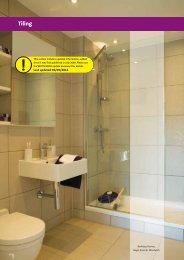SITE BOOK - Plaster systems - British Gypsum
SITE BOOK - Plaster systems - British Gypsum
SITE BOOK - Plaster systems - British Gypsum
Create successful ePaper yourself
Turn your PDF publications into a flip-book with our unique Google optimized e-Paper software.
www.british-gypsum.com<strong>Plaster</strong> <strong>systems</strong>9420to storage of chemicals, are particularly at risk from thisproblem.Thistle Dri-Coat should not be used in these situationsunless a proper survey shows that the risk from salts isminimal. An independent wall lining may be a bettersolution. Chimney breasts are another area where saltdeposits may be heavy.Replastering walls - following damp proof coursetreatmentThistle Dri-Coat is the only <strong>British</strong> <strong>Gypsum</strong> plasterrecommended for this application. The source ofpenetrating or rising dampness must be identified andeliminated. The existing plasterwork should be hacked offto a height at least 0.5m above either the new damp proofcourse or the last detectable sign of dampness. Where theold plaster is gypsum based, it must be completely removedfrom the area to be replastered. Ideally, replastering withThistle Dri-Coat should be delayed as long as possible toallow the background to dry out. After chemical dampproof injection, old mortar joints which are the site of thehigher salt concentrations should be thoroughly raked outand the face of the brickwork brushed with a wire brush.Before replastering work is carried out, any salts brought tothe surface of the background during drying should becarefully removed.Angle beads must not be fixed with gypsum basedmaterials, use Thistle Dri-Coat.The background must be clean, sound, and free from dustand efflorescence. Where only residual moisture is present,Thistle Dri-Coat can then be applied. Low suction or smoothbackgrounds, such as engineering bricks, should be treatedprior to plastering with a water-resisting bonding aid whichshould be plastered in accordance with the manufacturers’recommendations.Where the background is dry, it is important to controlsuction with the application of water. This prevents rapiddrying of the plaster which would impair its strength.Replastering walls - general applicationWhere the wall to be replastered is damp, replasteringshould be delayed as long as possible to allow thebackground to dry out. Any source of penetratingdampness must be identified and eliminated. Beforereplastering, any salts brought to the surface of thebackground during drying should be carefully removed.The background must be clean, sound, and free from dustand efflorescence. Where only residual moisture is present,Thistle undercoats can then be applied.





